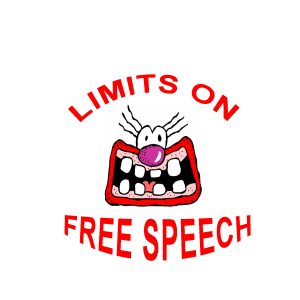
I took the USA Today quiz and found out I didn’t know very much about the first amendment. You can take it here. I hope you score better than I did.
http://usatoday30.usatoday.com/news/nation/2011-06-29-first-amendment-quiz_n.htm#
Turns out, as a country, we have struggled to define exactly what free speech is. The system works this way: people argue over what the First Amendment actually means and then wind up in court. Different decisions are appealed to the Supreme Court, that interprets the First Amendment. The court has determined that:
Freedom of speech includes the right:
- Not to speak (specifically, the right not to salute the flag).
West Virginia Board of Education v. Barnette, 319 U.S. 624 (1943). - Of students to wear black armbands to school to protest a war (“Students do not shed their constitutional rights at the schoolhouse gate.”).
Tinker v. Des Moines, 393 U.S. 503 (1969). - To use certain offensive words and phrases to convey political messages.
Cohen v. California, 403 U.S. 15 (1971). - To contribute money (under certain circumstances) to political campaigns.
Buckley v. Valeo, 424 U.S. 1 (1976). - To advertise commercial products and professional services (with some restrictions).
Virginia Board of Pharmacy v. Virginia Consumer Council, 425 U.S. 748 (1976); Bates v. State Bar of Arizona, 433 U.S. 350 (1977). - To engage in symbolic speech, (e.g., burning the flag in protest).
Texas v. Johnson, 491 U.S. 397 (1989); United States v. Eichman, 496 U.S. 310 (1990).
Freedom of speech does not include the right:
- To incite actions that would harm others (e.g., “[S]hout[ing] ‘fire’ in a crowded theater.”).
Schenck v. United States, 249 U.S. 47 (1919). - To make or distribute obscene materials.
Roth v. United States, 354 U.S. 476 (1957). - To burn draft cards as an anti-war protest.
United States v. O’Brien, 391 U.S. 367 (1968). - To permit students to print articles in a school newspaper over the objections of the school administration.
Hazelwood School District v. Kuhlmeier, 484 U.S. 260 (1988). - Of students to make an obscene speech at a school-sponsored event.
Bethel School District #43 v. Fraser, 478 U.S. 675 (1986). - Of students to advocate illegal drug use at a school-sponsored event.
Morse v. Frederick, __ U.S. __ (2007).
Additionally, we do not have the right to plagiarize copyrighted material, defame others (libel and slander), make true threats, or incite illegal actions or solicit others to commit crimes.
A historical look at past definitions of obscenity highlights our struggle to define free speech. On March 3, 1873, Congress passed An Act for the Suppression of Trade in, and Circulation of, Obscene Literature and Articles of Immoral Use. This legislation was commonly called the Comstock Act, after its champion Anthony Comstock. The crusader additionally targeted the contraceptive market because he believed that the availability of contraceptives was responsible for encouraging lust and lewdness.
The criminalization of the sale, distribution, or advertisement of materials that could be used for contraception or abortion was included. Sending information through the postal system or importing it from abroad was forbidden.
Change began in 1914 when birth-control advocate Margaret Sanger fled the country after a federal grand jury indicted her for mailing obscene materials. She had mailed copies of the Woman Rebel, her monthly publication, containing birth control information.
By the end of 1915, however, public opinion began to evolve. Support grew for amending the Comstock Act. Birth control leagues were established in cities across the nation. Eventually, the charges against Sanger were dismissed.
The takeaway is that we will see new definitions of free speech emerge as our society progresses and attitudes change.
Sources:
http://people.loyno.edu/~kchopin/new/related/comstock.html
https://www.pbs.org/wgbh/americanexperience/features/pill-anthony-comstocks-chastity-laws/
https://law.jrank.org/pages/12350/Comstock-Law-What-happened-next.html
https://www.washingtonpost.com/news/volokh-conspiracy/wp/2017/03/24/sex-and-the-constitution-margaret-sanger-and-the-birth-of-the-birth-control-movement/

Recent Comments